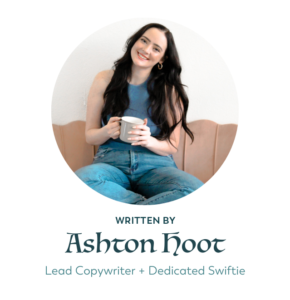Stories are everywhere, and we eat them up. The human brain loves a good story because, scientifically speaking, they cause reactions in our brain connections and chemistry.
Think about it. Some of the earliest humans sat around a fire, telling stories. It’s ingrained in our DNA. But in non-scientific terms — stories make us feel something.
And when a story’s got a recognizable character, a journey, a conclusion, and an emotional connection, we’re sold.
Think about it: When you connect with someone, especially through their “story,” how do you respond? You probably have more trust and like them a whole lot more — especially if the story is relatable to you or you can picture yourself in their shoes. If they were just some person on the street you said good morning to, it wouldn’t have half as much impact.
It’s why we love books, movies, and a good Netflix binge. Storytelling is arguably one of the most important elements of human behavior and it’s what keeps us connected in an increasingly online world.
Why storytelling matters for marketing
Storytelling isn’t just good entertainment — it also makes for a great sale. Through storytelling, businesses can form a better connection with their audiences, which is non-negotiable.
And it all goes back to the principle that we use those stories to learn, form a perspective about the world, and connect with others. Marketing tactics may change with time, and technology can advance, but we will never stop being human and craving connection, no matter where we are or what we’re doing.
And that’s really the bottom line for why it matters. Without connection, it’s hard to sell.
Storytelling in copywriting
Chances are you’re already doing plenty of storytelling in your content. We tend to write more like how we talk when writing things like blogs or social captions. And we naturally lean towards using stories to make our point.
“One time I was gardening and I realized…”
“And that’s when I realized the advice my mom gave me was right along…”
“When I first started my business, I wasn’t always thinking about content. Instead, I was…”
But while your copy is probably fine on this front, pay attention to your sales pages and other pieces of sales copy. That’s where storytelling lacks the most.
With sales copy, we’re eager to get to the point because we know that’s what our audience wants…right? Ehh, not exactly. We’re always told to cut the fluff, especially when it comes to promoting our offers.
But stories aren’t fluff. They’re powerful selling tools.
And skipping out on them can actually take you further away from the point because it will always leave your audience asking, “Well, why should I care about it.”
It’s not always about the features; it’s about the connection. You have something unique to contribute to your niche and your industry, and you show that off through the stories you tell. Otherwise, you’re just another used car salesman desperately offering up that ‘97 Chevy no one really wants.
How to use stories (and use them well)
So now that you know storytelling matters…how do you put it into your copy?
Remember — it’s not all about you
We love hearing stories, but most of the time, only if we can connect with it. If there’s nothing in it for us (even if that just means baseline interest), then we don’t want to hear it. The same goes for your audience when we’re talking about sales copy.
Use stories that they can find recognition in. You can start with prompts like:
- A time you felt lost and found clarity by using the same principles and ideas you’re selling
- How Googling everything all night every night was draining, the impact it had on your life, and how you don’t want your audience to have to do the same
- Explain how your offer would have been helpful for past you
And when in doubt, use these to bring it all together:
- “I don’t want the same for you”
- “Can you relate?”
- “I bet you’re the same, huh?”
- “I only WISH that I had this when I started my business”
Sometimes, something as small as a simple phrase can be enough to spark that much-needed recognition.
Define the main character
I know we all really want to be that quirky, interesting, manic pixie dream girl from our favorite 2000s movie (500 Days of Summer, anyone? What a classic.), but when we’re talking about storytelling in sales copy, you simply cannot be her. Your audience has to be.
Your website and content are great spaces to discuss your unique selling point, but the focus should always be on your clients and customers. They’re looking at your business because of something they need (or want). Again, everyone is looking to see what’s in it for them.
But if you can find a way to tailor your copy to show them that, then you’re golden.
Show off social proof
Sometimes, it’s hard to think of a million stories to scatter across your content. Or you can’t think of how exactly to verbalize the value of a product or service you offer. That’s where testimonials can be a powerful addition to your copy. Don’t be stingy with them! I always say that social proof is the best marketing — mostly because it uses storytelling to do it.
Avoid rambling
Yes, stories should be used, especially in things like sales pages, to avoid lack of detail. But you’ll be counteracting the point of stories (to build connection) if your story is the length of a master’s thesis and doesn’t have a point.
This isn’t a conversation with your bestie. Stay on target.
Don’t be scared to show off your personality
It’s a lot easier for people to pick up on a generic, cookie-cutter story than you think. Your audience is a lot smarter than they were even just 10 years ago, and because of the uptick in technology and available DIY marketing resources, they can also tell when something was just thrown in there from a swipe copy file.
I’m not dissing swipe copy. It can be a lifesaver! But I am dissing the use of swipe copy verbatim and not adding a single personal touch to it. Yawn. Make it unique, make. it. you.
Get a copywriter to help
Read all this and started thinking…”I’m still not sure I can get this done on top of my 542 tasks this week alone!”…you know we got your back. Give us a ring and let us help you. We’ll take your stories and craft them into strategic pieces of copy — it’s *kind of* our thing.

